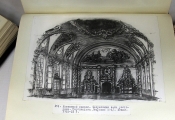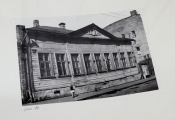Sense of time. Architecture of Moscow in dissertations
30.01.2013
Within the framework of the collection there could be found 34 works consisting of two, three and four volumes. Of even six volumes there consisted the dissertation by I. Novikov “Kazan railway station in the ensemble of the Komsomolskaya square of Moscow” created with the professor B. Mikhailov's scientific advice.
The objects of pure interest could be found the research works devoted to the planning and building of embankments and the central part of the city. One could explore the captivating world of photos and schemes of the old streets of Moscow and compare those views with the present ones seen outside. T. Sokolova in her dissertation “Principles of research of a historical building site (on the example of Gertsen Street in Moscow)” tried to define general principles of city building in Gertsen street (now known as Bolshaya Nikitskaya) within the boulevard encirclement, and she tried to trace those principles during six chronological stages. The reconstruction of the structure of the street was based on topographical and iconographical materials, on the information of the Pistsoviye knigi (annals) and other written archived materials.
Anyone living or staying in Moscow would appreciate the information on the development of architecture of the underground of the capital. It could be followed, for instance, in M. Toskunova’s dissertation research. She generalized all the methods and means of forming architecture of the underground into recognizable images. The second volume of the dissertation contained appendixes with tables reflecting artistic history of the architecture of the underground stations: there could be found station names with brief characteristics, as well as the names of the architects, sculptors and artists working on each of them.
Architecture of palaces, wooden houses, railway stations, underground; planning and building of the centre of Moscow, embankments and streets – all those were just sample themes of the works represented at exhibition “Sense of time. Architecture of Moscow in dissertations of 50-90s” which took place in the Blue exhibition hall of the RSL 16 – 31 January, 2013. The main aim of the exhibition was to demonstrate the uniqueness of the dissertation collection of the national library, for, as the organizers of the exhibition stated, numerous works had been lost inside universities, and now they were only accessible at the RSL.
 |
The works chosen for the exhibition impressed by the diversity of themes. These were, for example, dissertations devoted to the palace ensembles of Moscow, such as “City mansion ‘High hills’”by A. Daniliak, “Kuskovo as historical and cultural complex of the 18th century” by V. Deliukhina, “Development of palace ensembles of Moscow in the first half of the 18th century (Lefortovo)” by O. Evangulova, “The ensemble of Tsaritsino and romantic trend in Russian architecture of the second half of the 17th century” by E. Shemshurina.
Some of dissertations depicted different trends of the architecture of Moscow: the romantic theme in the architecture of Moscow of the 18-19th centuries, the gothic theme in the architecture of 19-20th centuries, Moscow rock architecture of the 16-17th centuries. Thus in “Moscow rock architecture of the 16-17th centuries. Customer’s role in creation of architectural forms” A. Batalov attracted our attention to the personality of customer and their influence on the future masterpiece.
 |
 |
Y. Fedorov’s dissertation “Architectural decisions for auto entrances in Moscow” written in 1954 stroke by its prophecy. Even then the author had worried about possible problems awaiting transport in Russian capital. He said that future urbanization, raise of cultural demands and material estate of the soviet people and growth of the number of automobiles were fraught with serious problems for the city traffic.
Among the dissertations represented at the exhibition there were also works devoted to the colours, landscape and interior of the architecture of the city. They were: “Architecture of wooden houses of Moscow of the first half of the 19th century”, “Architectural analysis of the interior of civil buildings of the end of the 18th century in Moscow (on the example of Demidov’s house)”, “Colours of the historical Moscow of 18-20th centuries”, “Architectural and landscape organization of tourist tours on the example of the city of Moscow”.
Visitors of the exhibition could get acquainted with each work in details, for there was organized a workstation where one could view the dissertations, read the interesting ones and browse through illustrations.
Wealth of architectural ideas, city images, buildings for exposition, railway stations and houses of the capital – all that could be found in the unique materials of the dissertations, and all that gave a chance to visitors of the exhibition well acquainted with the Moscow of nowadays to have a look at the images of the past and to feel the breath of time.


 Virtual Keyboard
Virtual Keyboard
 по-русски
по-русски

